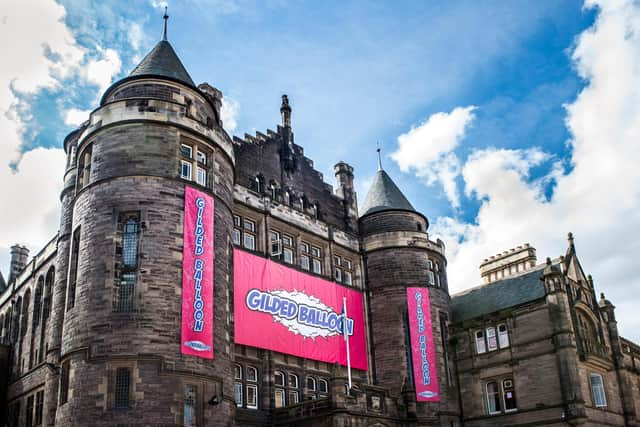How I would save the Edinburgh Festival Fringe - Joe Goldblatt
and live on Freeview channel 276
This distinction is important because although there are now over 60 other festivals throughout the world with the name Fringe included along with their place name such as the Adelaide Fringe, the DC Fringe and more, there is and will only ever be one maternal home of this global cultural phenomenon.
However, we must act now and with confidence to insure that we continue to secure and cultivate its rich contributions to our nation and to the entire world.


Advertisement
Hide AdAdvertisement
Hide AdIn 1947, when two Jewish refugees from Nazi persecution, Sir Rudolf Bing and maestro Bruno Walter along with others, launched the Edinburgh Festival of Music and Drama, almost simultaneously eight other theatrical companies from Scotland and England who were not invited to perform at this festival, arranged their own venues and the curtain was raised upon a new kaleidoscope of music, drama, comedy, dance, circus arts, and much more known ubiquitously as simply the Fringe.
Incidentally, not only is Edinburgh the maternal home of the Fringe, it is also the city that gave birth, through Professor David Brewster, to the kaleidoscope.
Brewster selected this word for his new invention because of the Greek origin of the words kalos for beauty, eidos for form and scopos for watcher.
The kaleidoscopic experience of culture in Edinburgh is now being watched world-wide to see if we may work together to retain and improve its beauty through a new and better form.
Advertisement
Hide AdAdvertisement
Hide AdDuring the intervening seventy years the Fringe has, to quote William Shakespeare, “suffered the slings and arrows of outrageous fortune” as its success has led to criticism from within and without.
The internal criticism often was the result of individual artists competing for parity and fairness amongst the major producers whose investments in marketing and logistics often dwarf the smaller productions. The exogenous forces include concerns about over tourism and its impacts upon the quality of life for local residents.
It appears the global pandemic has brought many of these age-old issues to a feverish boil and there is now a great risk for Scotland’s capital city and other cities throughout the world who host Fringe festivals that these competing forces may lead to diminishing future returns for what was the world’s largest arts festival.
I am deeply concerned about this prognosis and therefore wish to offer the following treatment plan to hopefully begin to heal the wounds that are seeking to kill something very special for all of us.
Advertisement
Hide AdAdvertisement
Hide AdFirst, I believe that our politicians have been remiss in not publicly speaking out even more forcefully, amongst the noise from local groups, to champion the important social, financial and other impacts of the Edinburgh Festival Fringe.
The City of Edinburgh Council appointed two councillors (Labour and SNP) as their ‘Festival's Champions’ and now I believe it is time to raise their profile to demonstrate the importance of this role.
Perhaps instead of champions we now need Festival Tsars to demonstrate the greater importance of these roles and our festivals now and in the future.
A Tsar in government is often granted broad powers to advance public policy. However, I further believe that championing the Edinburgh Fringe should also be the role of all councillors and citizens, as it was in 1947, to recognise that supporting the arts is our civic duty.
Advertisement
Hide AdAdvertisement
Hide AdSecondly, the Fringe itself must seek opportunities to create even stronger and more effective links with civic organisations to promote better understanding, respect, and support for their important contributions to our city, country and indeed the entire world through the thousands of performers who visit Edinburgh each summer.
The Fringe’s chief executive has done an exemplary job in serving as an effective spokesperson for her organisation.
However, now it is time to greatly amplify her voice with messages of support from organisations that provide social, health, education, recreation, environmental safety and security services for our city, proclaiming through their endorsement that this programme is indeed a civic asset that must be enshrined in the future life of our city.
Thirdly and finally, it is now time to initiate a multi-year, strategic planning process for the Fringe to identify the goals, objectives, and measurable targets that will be welcomed by local residents, performers and audience members in the next five to ten years.
Advertisement
Hide AdAdvertisement
Hide AdThis process must be transparent and include a cross-section of the community, including those that have been critical in the past.
I believe the outcome of this process will result in a road map to future cultural sustainability and excellence, the likes of which have not been seen in our city since the reactionary establishment of the Fringe in 1947.
The mother of all Fringes in Edinburgh must now receive our well-deserved respect and commitment to provide compassion, empathy, and support to insure that her future years are celebrated and enjoyed with dignity and good health.
One of the persistent overarching questions asked about the future of the Edinburgh Festival Fringe is “how much is too much?”
Advertisement
Hide AdAdvertisement
Hide AdIf we simply dismiss this opportunity due to our fears of returning to a time where we failed to ask how much is too much, we shall dishonour the values and aspirations of those civic leaders and artists that gave birth to the original festival and established Edinburgh as the maternal home of festival excellence.
- Professor Joe Goldblatt is emeritus professor of planned events at Queen Margaret University. He has been studying and writing about the Edinburgh Festival Fringe for nearly 50 years. For more information about his views about Edinburgh’s festivals and other topics visit www.joegoldblatt.scot.
Comment Guidelines
National World encourages reader discussion on our stories. User feedback, insights and back-and-forth exchanges add a rich layer of context to reporting. Please review our Community Guidelines before commenting.
